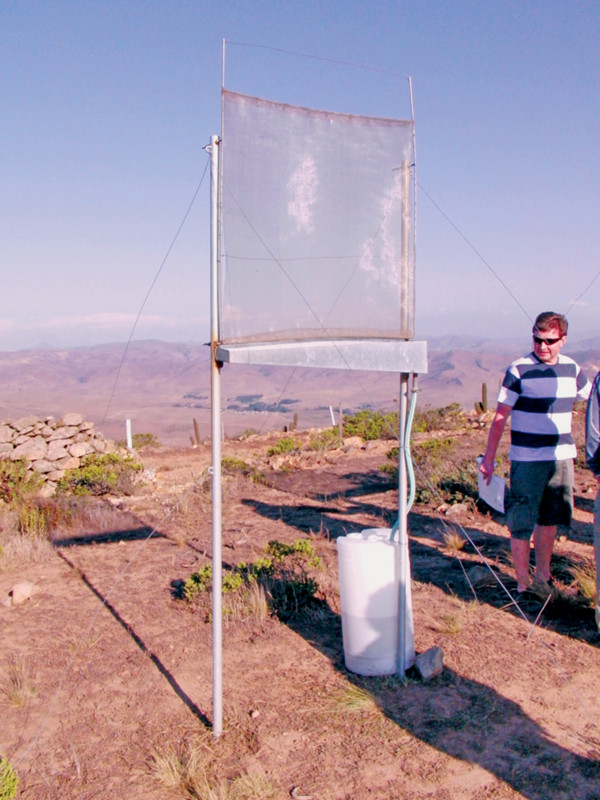
by Sam Lemonick Monday, January 13, 2014

Fog collectors resemble volleyball nets with tighter weaves. Standard fog collectors are getting a boost with an optimized stainless steel mesh, as shown here near Pena Blanca, Chile. Water is collected in the white plastic drum. K.C. Park
In northern Chile, as in many other parts of the world, freshwater is a limited commodity, but heavy fogs are a regular occurrence. For at least two decades, people in such areas have turned to fine mesh nets to harvest moisture from fog, but to date the nets have never been terribly efficient. Now, new research could greatly improve the nets’ efficiency, increasing the amount of water they’re able to capture.
Predominantly made of plastic fibers and usually placed on hillsides, fog collectors look something like volleyball nets with a much tighter weave. Droplets run down the mesh into a trough or bucket, where the water can be collected for drinking by people or livestock, or for irrigation.
Current meshes collect about 2 percent of the moisture that passes through them, says Gareth McKinley, a mechanical engineer at MIT. Hoping to improve the meshes, McKinley and MIT chemical engineer Robert E. Cohen reimagined mesh technology, starting with computer models and working up to field-ready prototypes that are about five times more efficient at harvesting fog. “For realistic wind speeds, realistic droplet sizes and realistic materials, that’s close to the maximum [efficiency] you could hope to achieve with a simple engineering design,” McKinley says.
The team began by optimizing the size of the fibers and the holes between them in the mesh. Commonly used meshes have holes about five millimeters apart, a little smaller than the width of a pencil. McKinley and Cohen’s team, however, found that meshes looking more like window screens are better, with filaments just 200 to 300 micrometers in thickness, or about two or three times thicker than an average human hair, and spaced apart twice that width. They also changed materials, opting for stainless steel over polyolefin, an inexpensive plastic. These improvements let the mesh collectors catch more water and also made them more resistant to damage, the team reported in the journal Langmuir.
“A useful analogy is to think about the difference between a simple windmill and a modern wind turbine. They basically use the same physics, but one of them has been massively optimized using engineered materials to operate at higher peak efficiency,” McKinley says. “With fog catchers, we’re still at that [stage] of the farmstead with a single windmill from the 1930s.”
The biggest improvement in the new harvesters is a coating that helps droplets run off the mesh more easily. By incorporating fluoride in the same manner as Teflon — used to coat nonstick cookware — the fluorocarbon coating works the same way on the mesh as products like Rain-X do on windshields, letting droplets slide down the fibers more easily.
With the help of Chilean collaborators from the Pontifical Catholic University of Chile in Santiago, McKinley and Cohen’s team are deploying one-meter-square test units in the country. With the region’s thick fogs and heavy winds, the researchers say they may be able to collect as many as 12 liters of water per day with each square meter of mesh. Their Chilean counterparts estimate that collecting just 4 percent of the moisture in the arid northern region’s fog could be enough to sustain its population — less than half the predicted output of the MIT fog harvesters.
In spite of its potential, some water resource experts caution that fog harvesting still has a lot to prove. “Although there are very successful fog collection projects, many have ceased operation,” says Otto Klemm, a climatologist at the University of Münster in Germany. There are other considerations, he says, like how to transport collected water or maintain the fog nets. “It does not make sense to simply put up a frame with a net for fog collection” without taking into account the practicality of the situation.
© 2008-2021. All rights reserved. Any copying, redistribution or retransmission of any of the contents of this service without the expressed written permission of the American Geosciences Institute is expressly prohibited. Click here for all copyright requests.